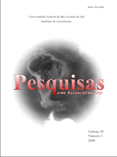Hydrodynamic evolution and bank erosive processes in the Channels of Upper Paraná River Floodplain System, South-Central Brazil
DOI:
https://doi.org/10.22456/1807-9806.20283Keywords:
Bank Erosion, Fluvial Geomorphology, Paraná river.Abstract
This paper intend to contribute on understanding of small part of tropical/subtropical large river fluvial geomorphology: the high Paraná river flood system. The studied area is inserted in Baía River Compartment, characterized of large alluvial plain, in the right margin of high Paraná River, and the greater archipelagoes subdividing the channel in branches with different importance. The intensity of erosive process on the Paraná River banks were studied in four different kinds of channel by 29 points, during a hydrodynamic cycle. The obtained data was still treated with cluster analysis and the correlation through the linear and exponential regression among variables. Results evidenced that the flow velocity and mechanical composition of banks were the main variables of bank erosion rates, and that the another variables, like roots and vegetation, do not had any influence to control the bank erosion. Erosion, accretion and by pass are processes controlled by the Paraná river regime, by shifting of the talweg position and then also controlled by intensity, duration and recurrence of flood.



